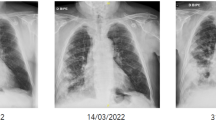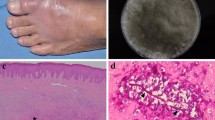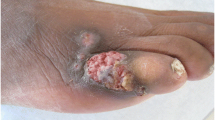Abstract
This report describes a 77-year-old man with cutaneous mycosis caused by Scedosporium dehoogii while taking oral betamethasone and tacrolimus for the treatment of rheumatoid arthritis. At examination in our clinic, the patient had multiple cystic lesions and nodules with slight tenderness, varying in size up to 4 cm, on his left knee and shin. He had not noticed any traumatic injury at the site of the lesions. Fungal cultures of samples taken from the abscesses, scales, and crusts of the lesions yielded white, later grayish brown, fluffy surfaced colonies. Partial sequencing of the β-tubulin gene confirmed the species of the isolate. The patient was initially treated with oral voriconazole and local hyperthermia, but experienced hepatic injury 2 weeks later. His treatment was changed to itraconazole (ITC) and local hyperthermia, followed by a combination of ITC and terbinafine. The patient recovered completely during the 12-month course of treatment.





Similar content being viewed by others
References
Gilgado F, Cano J, Gené J, Sutton AD, Guarro J. Molecular and phenotypic data supporting distinct species statuses for Scedosporium apiospermum and Pseudallescheria boydii and the proposed new species Scedosporium dehoogii. J Clin Microbiol. 2008;46:766–71.
Li FG, Yang YP, Li W, et al. Spontaneous remission of subcutaneous scedosporiosis caused by Scedosporium dehoogii in a psoriatic patient. Mycopathologia. 2017;182:561–7.
Gilgado F, Cano J, Gené J, Guarro J. Molecular phylogeny of the Pseudallescheria boydii species complex: proposal of two new species. J Clin Microbiol. 2005;43:4930–42.
Lackner M, Hagen F, Meis JF, et al. Susceptibility and diversity in the therapy-refractory genus Scedosporium. Antimicrob Agents Chemother. 2014;58:5877–85.
Troke P, Aguirrebengoa K, Arteaga C, et al. Treatment of scedosporiosis with voriconazole : clinical experience with 107 patients. Antimicrob Agents Chemother. 2008;52:1743–50.
Lackner M, de Hoog GS, Verweij PE, et al. Species-specific antifungal susceptibility patterns of Scedosporium and Pseudallescheria species. Antimicrob Agents Chemother. 2012;56:2635–42.
Takeuchi A, Hamaguchi Y, Fujimoto M, Takehara K, Anzawa K, Mochizuki T. A case of deep cutaneous mycosis by Scedosporium apiospermum in a pemphigus foliaceus patient under immunosuppressive condition. Jpn J Dermatol. 2014;124:1135–40 (in Japanese).
Watanabe S, Anzawa K, Mochizuki T. Hepatic dysfunction caused by systemic voliconazole for treating a mycotic cyst caused by Scedosporium apiospermum. J Dermatol. 2017. doi:10.1111/1346-8138.13980.
Matsumoto K, Ikawa K, Abematsu K, et al. Correlation between voriconazole trough plasma concentration and hepatotoxicity in patients with different CYP2C19 genotypes. Int J Antimicrob Agents. 2009;34:91–4.
Kubota T, Chiba K, Ishizaki T. Genotyping of S-mephenytoin 4′-hydroxylation in an extended Japanese population. Clin Pharmacol Ther. 1996;60:661–6.
Meletiadis J, Mouton JW, Meis JFGM, Verweij PE. In vitro drug interaction modeling of combinations of azoles with terbinafine against clinical Scedosporium prolificans isolates. Antimicrob Agents Chemother. 2003;47:106–17.
Acknowledgements
The authors thank Dr. Tetsuhiro Toga at Nihon Nohyaku Co., Ltd., Japan, for the determination of minimal inhibitory concentrations of antimycotics on the fungal strains. This study was partially supported by the Research Program on Emerging and Re-emerging Infectious Diseases from Japan Agency for Medical Research and Development, AMED.
Author information
Authors and Affiliations
Corresponding author
Ethics declarations
Conflict of interest
The authors declare there are no conflicts of interest including industrial links or affiliations.
Rights and permissions
About this article
Cite this article
Sakata, Y., Taga, F., Ushigami, T. et al. A Case of Cutaneous Mycosis Caused by Scedosporium dehoogii on an Immunocompromised Patient. Mycopathologia 183, 465–470 (2018). https://doi.org/10.1007/s11046-017-0198-5
Received:
Accepted:
Published:
Issue Date:
DOI: https://doi.org/10.1007/s11046-017-0198-5




